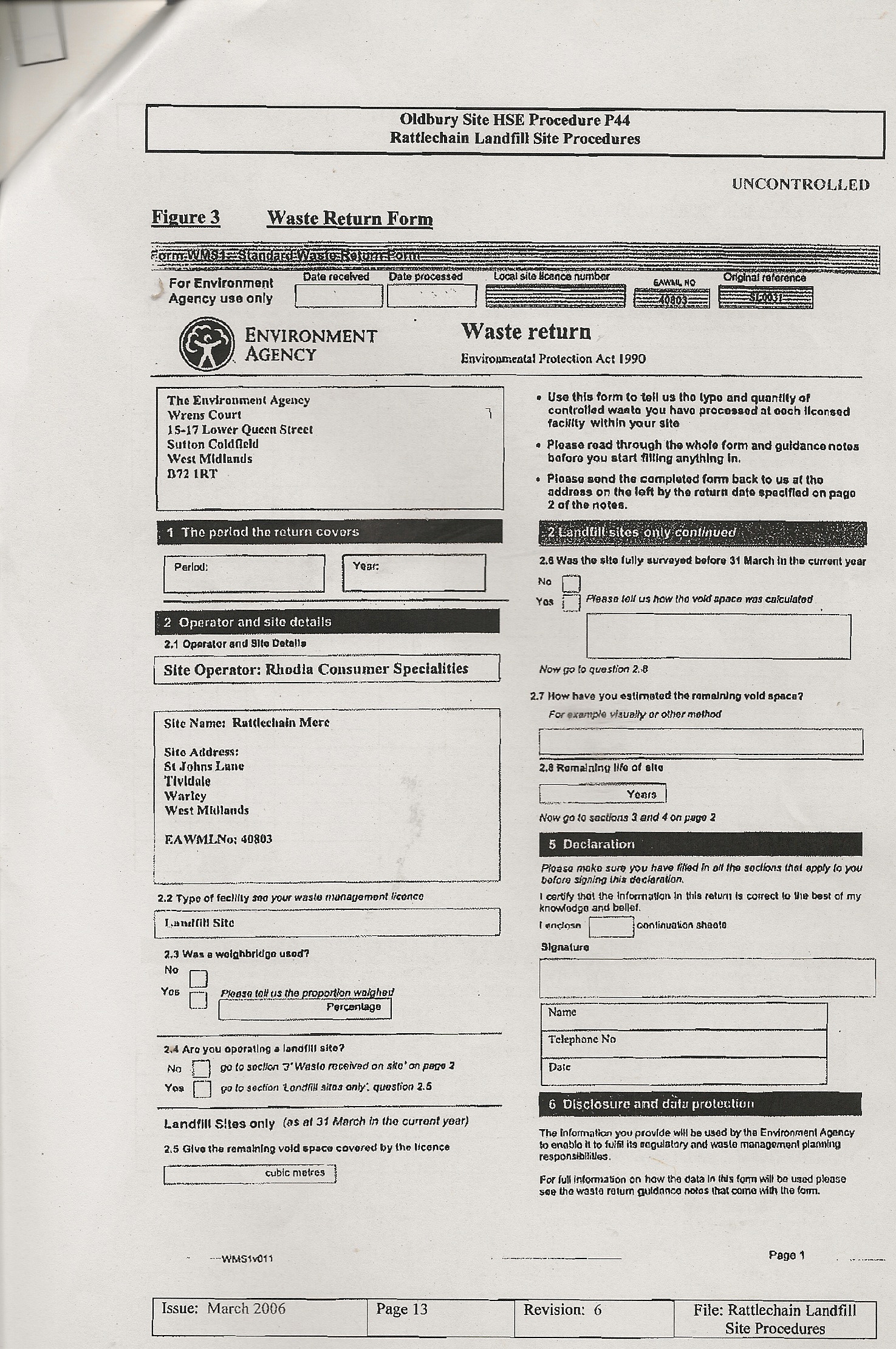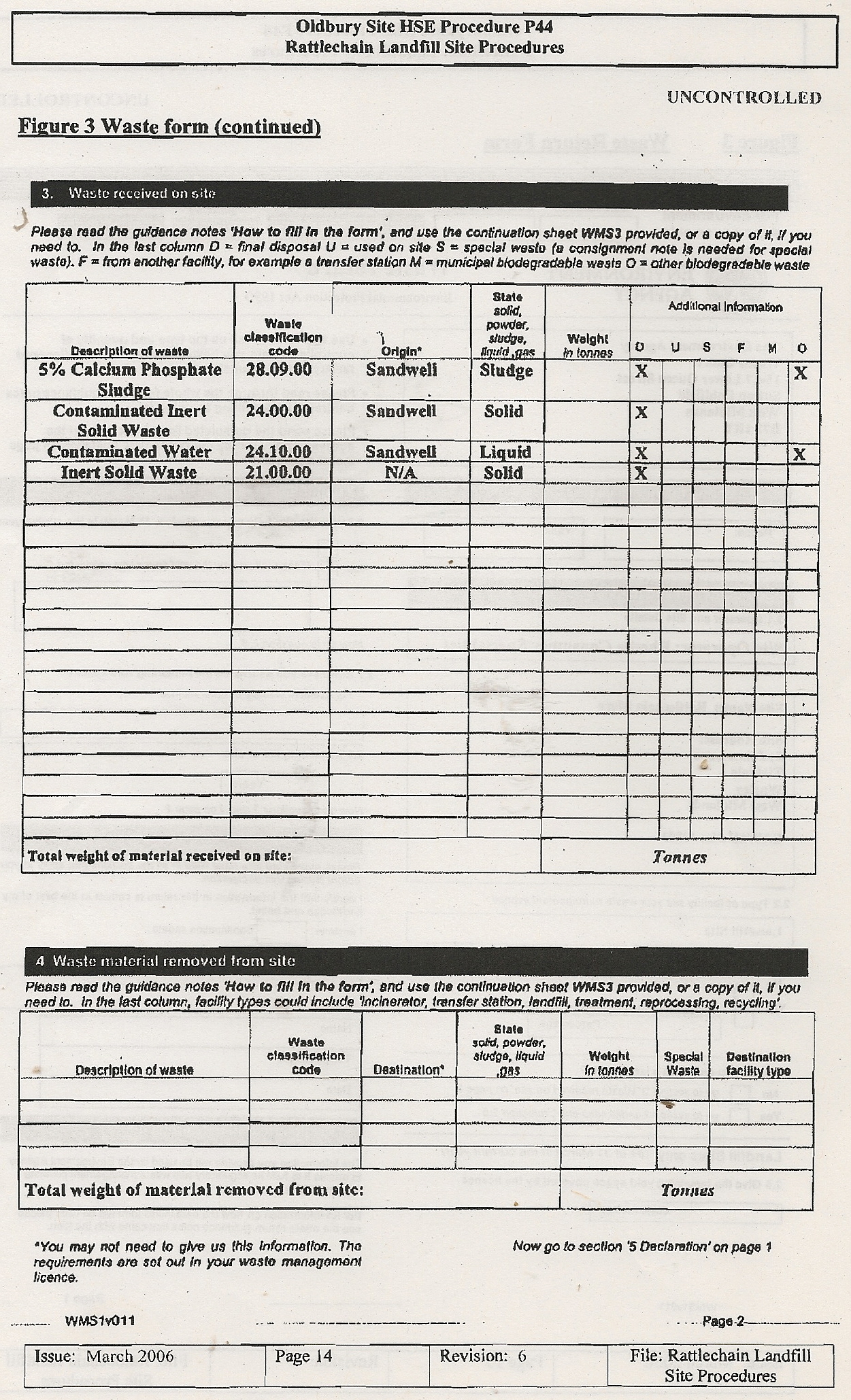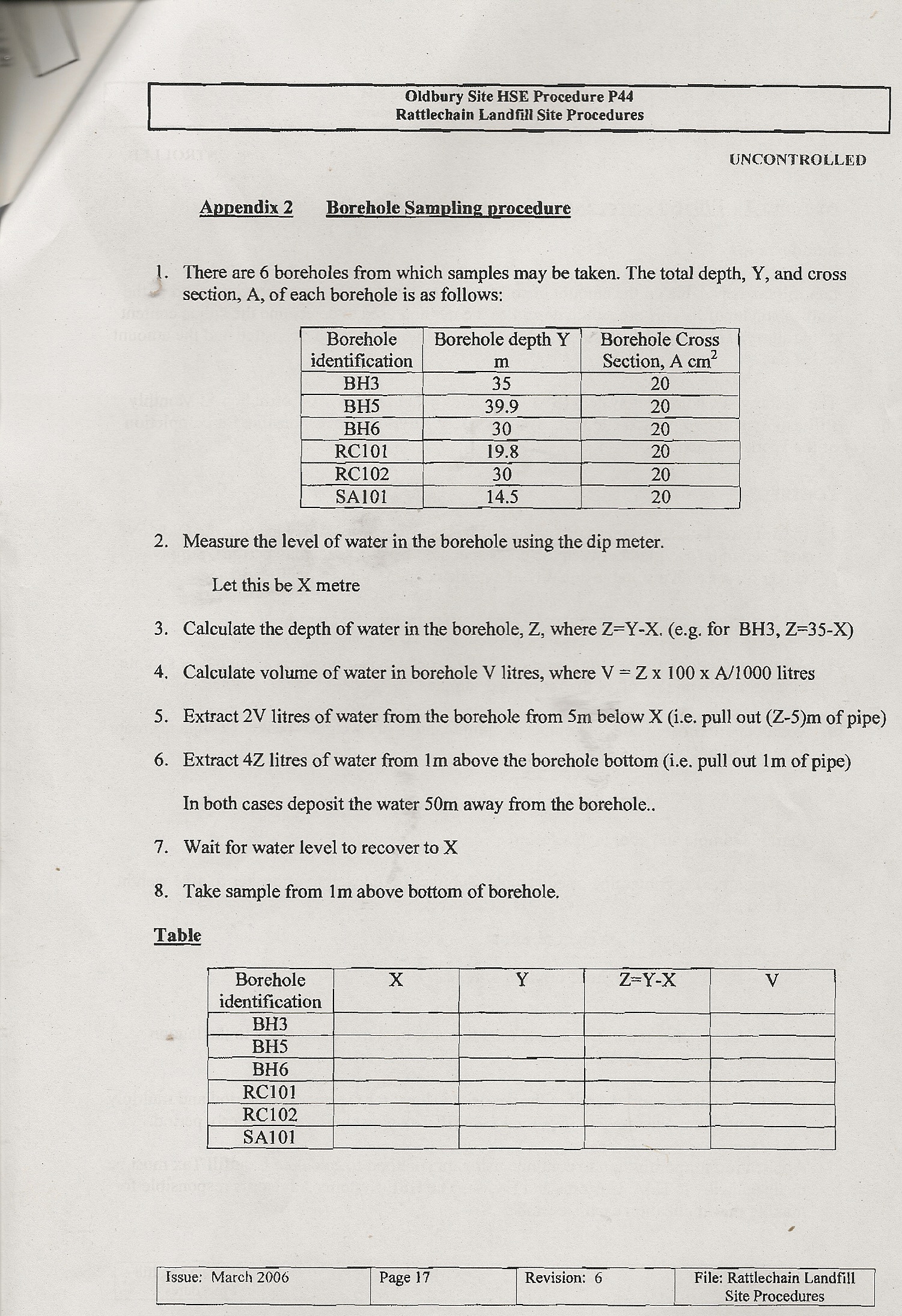“The most ugliest place I ever saw…..
….all the ugliest waste of the world from a single works…..”
The following account is the account of Rhodia’s “Rattlechain lagoon site procedures”- as given to the Environment Agency as part of their closure plan for the site. This was submitted in 2006, when active waste disposal had supposedly ceased at the site.
This 19 page report is shown below in full, and was supplied to us by The Environment Agency as part of a freedom of information request. It is clear that this document has undergone previous, and probable subsequent revisions. This 6th revision contains some interesting background information regarding “the theory” behind the site procedures. As we demonstrate with “direct evidence”, the actual facts of the operation were somewhat different. We have also added some pictures and further information to annotate the events described in this HSE procedure P44.
NB R. Evans and Tom Dutton are on the Rhodia UK Limited board of directors, the latter being the Health and Safety Director.
This table confirms that 6 revisions of this document took place between July 2003 to March 2006- the month when waste apparently was no longer tipped. Page 16 refers to discharge consents
This is the list of contents in the report. Note the insertion of red text that is shown throughout the document. The use of the word “historic” is totally misleading- given that waste had only just stopped being deposited into the lagoon. It also ignores the “historic” tipping before licensing in 1978 from 1942 onwards and via canal barge, when no controls would have been in place. Anyone reading this document alone without informed knowledge could be easily fooled.
Many past tense insertions are added in red, indicating that the former revision would have used the present tense when waste was still being actively tipped in this manner. Some comments should be made in respect of Rhodia’s claims.
- The lagoon is filled with a variety of unclassified chemical wastes including toxic white phosphorus, and not just “Water”!
- The use of the word “clean” to describe the smaller lagoon is important as it is anything but clean- and this appears to be used to describe its difference from the other lagoon rather than admitting that it was “unclean” and contaminated with historic chemical waste. It was created from one single pool after waste tipping had been commenced and deposited for many years.
- The claims by Rhodia concerning the % weights of calcium phosphate have been repeated by them many times in writing and in press releases. Never demonstrated is any “direct evidence” of any independent monitoring of what % this actually did contain- that is because there never was any carried out.
THE TRINITY STREET RATTLECHAIN PROCEDURE LINK CYCLE
- Park Environmental also carried out the contract for waste disposal for Albright and Wilson and Rhodia at Rattlechain lagoon
- Only one tanker lorry weighing was carried out- this could have effectively have meant that this first shipment of waste was recorded for official purposes but the tanker may not have been “full”. Subsequent assumptions that successive shipments of sludge were the same weight could mislead as to quantities actually being deposited at the Rattlechain site- thus a licence breach could have occured.
- It is clear that not all tanker drivers followed the procedure of locking the gates between runs. We witneseed open gates on many occassions and tresspassers who had gained access via the open gates! AT THIS POINT IN TIME UPTO 2010 THERE WAS NO CCTV ON SITE.
- This page confirms that waste was being discharged 7 days a week, 52 weeks of the year.
- “Further waste characterisation and acceptance procedures are condidered unnecessary.”
This is exactly the type of arrogance that this company have portrayed throughout their history. The fact that this is accepted by their regulator shows that they were and remain unfit for that role. These consignments of waste could be easily falsified. There are no spot checks, no confirmation or independent monitoring of whether the consignments of waste are real or invention. It is effectively self regulation. It also led to potential arguments in terms of calculating landfill tax- as this set of letters confirm– supplied to us via an FOI request to the Environment Agency.
FROM TANK TO TIP
The Trinity Street factory effluent treatment plant at 3/5/99 is shown below in the Google Earth picture.
This google Earth picture from December 2001 shows the process described in 2.0 (iv). The tanker is discharging waste into the lagoon. Note the large amount of weed surrounding the pontoons and the waste build up in the “beach area”. The houses adjacent to the site had not yet been built. Remnants of the former sewage works that they would be built on top of are visible.
- The waste declarations are entirely dependent on the honesty of one single person- the HSE Secretary.
- This section remains in the present tense- indicating that either they had not looked very thoroughly at revising the content into the past tense or they reserved the right to deposit further wastes on request.
- The onus on the contract haulier to complete checklist observations are unfair. This effectively admits that this company was leaving bird death observations on site as well as security concerns to an outside source. It could then deny any direct wrongdoing on the part of the HSE manager, even though he was ultimately responsible (other than the Oldbury site manager) for all events on site. Would a tanker driver in reality have diligently scoured the site looking for things that did not relate to discharging waste?
- What counts as a “significant observation”? This appears to be on the same lines as the EA 1997 audit which criticised the manner in which incidents were reported- linked to manager bonuses for not reporting environmental incidents.
- The former concrete panel fencing was notoriously liable to breakage, vandalism and tresspass- as indicated in the following EA inspection form supplied to us via an FOI request.
This picture shows John’s Lane in 2006 with the concrete panel fencing described in 4.1. The right hand side shows the containers stored at this time on the “autobase site”. Note the newly replaced concrete panels which are visible. We had started reporting these incidents directly to the HSE manager by this time.
This EA incident report form dated 8/2/06 states
“No site returns received since July 05. Please provide information up to date within 2 weeks.”
NB Rhodia were not conforming to their own site procedures, not completing landfill tax assessments and had only a few weeks left of authorised tipping. Did they provide them, and why did it take the Environment Agency seven months to realise that they had not received up to date records?
- “The HSE manager is responsible for reporting any significant environmental effects to the Environment Agency.” Do Rhodia maintain the bonus system that Albright and Wilson were criticised for regarding the potential non reporting of such incidents?
- “At no time is the lagoon level alowed to overtop the causeway.”
This happened on many many occasions as reported to the company by The Environment Agency. Once again, little action ever followed.
- “The HSE systems advisor” is responsible for reporting “dead animals” and “fires” amongst other things- no direct reference to white phosphorus, but clear indications of what his observations would have been caused by.
- This confirms that the HSE manager is responsible for “remedial action”- how can he bring back dead poisoned animals. No “remedial action” was ever taken by the HSE manager- just excuses and a series of denials concerning the sediment characteristics, that his company were never questioned about.
- Concerning the URS hydrogeological risk assessment, we would beg to greatly differ. Not considered in this document is the effect on wildlife- there was no talk of “protecting wildfowl” here, or in this document either.
- Rhodia commission an environmental consultant to undertake work based on what they tell the environmental consultant. The same method followed with the HPA paid study.
- The talk of “monitoring” is not very reassuring given either this company’s record of health and safety or honesty.There is no assessment of the chemical constituent white phosphorus.
- The sampling of boreholes also appears to be stacked in the company’s favour. It offers no real time analysis of events or changes in concentrations. What is an “adverse trend”- what is the definition of this, did the EA set one?
- The risk assessment by the environmental consultant recommended the trigger levels- not the Environment Agency Regulator- is this their job?
- The risk assessment appears to initiatiate a further risk assessment according to this bland statement.
The URS Hydrogeological risk assessment is a 20 page document filled with conflicting historic references supplied to the Environmental consultant by Rhodia. It is largely based on information given by Rhodia and unpublished and as yet unreleased information collected by URS from earlier in the decade. The Environment agency have confirmed that they have not asked for or hold this report. Rhodia’s line at a meeting of the “rattlechain steering group” was that it was “commercially confidential.”
The internal boreholes within the Rhodia site boundary are situated within the current site boundary and not the historic one, prior to 1974. They do not reflect the rerouted John’s Lane or changes over time to the adjacent landfill site. It also appears to be an attempt to claim there is off site contamination entering the lagoon from this source as evidenced in the URS Hydrogeological risk assessment. None are within the lagoon sediment/water itself.
- The following form confirms that the EA were happy with Rhodia calling the site “Rattlechain Mere”
- “The Information you provide will enable the Environment Agency to fulfill its waste management and regulatory planning responsibilities.”
So it follows that if this company had failed to submit records for several months in 2005, then the regulator were not fulfilling its waste management and regulatory responsibilities?
- The following form shows “waste codes” for classification. It should be noted that the historic wastes had no waste codes at all, because it was a free for all tip, as evidenced by the British Waterways correspondence to Albright and Wilson.
- The descriptions are also so vague as to be meaningless. “Contaminated water” could be someone spitting into a bucket to phossy water- which is what this is.
- The definition of “Inert wastes” was unsatisfactory from the issue of the waste management licence in 1978. If something is “inert” it does not poison living things.
- The weight of wastes, and their more definitive characteristics recorded in tonnes can therefore be falsified within these vague catogories. The EA supplied us with a freedom of information request answer where we sort information relating to the original descriptions of wastes in the SL31 licence. The blurring of these terms in this waste classification means that waste contaminated with phosphoric acid for example would not be recorded as explicitly so- but it would have been likely to be present in “contaminated water”- it is just not specified as such.
The Rattlechain “routine issues” form is shown below.
“Wildlife issue”- is obviously a reference to dead birds on the water, but just not a specific one. The only wildlife issue is that the lagoon is contaminated with toxic white phosphorus, but they knew this already so did not have to comment on this form
The following discharge consent limits have been confirmed for us in a freedom of information request to The Environment Agency. As has the fact that there is no consent limit for white phosphorus or its breakdown products, and they have no accredited method for testing for the chemical from the sampling point into The Birmingham Canal Mainline.
The depths of boreholes given below are interesting given the historic confirmed depths of the former Rattlechain Brickworks claypit- “100 yards deep.” They do not get down at their deepest to half way this depth.
- The following calculation is a rather potty one to follow. Who came up with this methodology and why was it being carried out in a sort of joint effort by the company contractor and then the HSE systems advisor?
- Would it not be better to maintain integrity of data by just one independent individual sampling the tankers- such as The Environment Agency Regulator, or better still H.M Customs and Excise given the potential for corporate fraud?
- As demonstrated previously, between July 05 to the close of tipping, Rhodia had not completed this exercise.
- The following table showing control and trigger levels confirm the limited set of determinands used in sampling. A 100 time increase to confirm a “trigger”- is this an acceptable remit to follow?
- It confirms that no elemental phosphorus testing or anything related to its breakdown products are sampled from this borehole
“The Mere, say it loud and Rhodia are trying,
say it soft and the birds keep dying, “The Mere” I’ll never stop cursing “The me-errrrr.!”




























